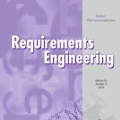Using models for requirements engineering (RE) is uncommon in systems engineering, despite the widespread use of model-based engineering in general. One reason for this lack of use is that formal models do not match well the trend to move towards agile developing methods. While there exists work that investigates challenges in the adoption of requirements modeling and agile methods in systems engineering, there is a lack of work studying successful approaches of using requirements modelling in agile systems engineering. To address this gap, we conducted a case study investigating the application of requirements models at Ericsson AB, a Swedish telecommunications company. We studied a department using requirements models to bridge agile development and plan-driven development aspects. We find that models are used to understand how requirements relate to each other, and to keep track with the product's evolution. To cope with the effort to maintain models over time, study participants suggest to rely on text-based notations that bring the models closer to developers and allow integration into existing software development workflows. This results in tool trade-offs, e.g., losing the possibility to control diagram layout.
翻译:在系统工程中,尽管普遍使用基于模型的工程模型,使用要求工程模型的情况并不常见,但在系统工程中,尽管普遍使用基于模型的工程模型(RE)很罕见,但系统工程中使用要求工程模型(RE)的情况很少,这种缺乏使用的原因之一是,正式模型与采用灵活开发方法的趋势并不完全吻合。虽然在系统工程中存在调查在采用要求模型和灵活开发方法方面的挑战的工作,但缺乏研究在灵活系统工程中使用要求模型的成功方法的工作。为解决这一差距,我们在瑞典一家电信公司Ericsson AB进行了一项案例研究,对需求模型的应用情况进行了调查。我们研究了一个部门,利用要求模型来连接快速开发和计划驱动的开发方面。我们发现,模型被用来了解要求彼此之间的关系,并跟踪产品的演变情况。为了应付在时间上维持模型的努力,研究参与者建议依靠基于文本的批注,使模型更接近开发者,并能够融入现有的软件开发工作流程。这导致了工具的权衡,例如丧失了控制图表布局的可能性。





